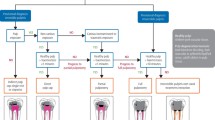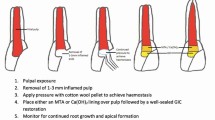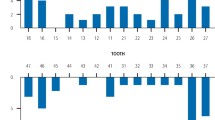Abstract
The preparation of an access cavity is the first part of endodontic treatment and is a key stage in the healing of both periapical and pulpal infections. It should allow endodontists to remove obstructions in the pulp chamber, locate all canal orifices and clean the entire root canal system with minimum coronal tooth structure removed. This has been done traditionally through establishing straight line access. The development of minimally invasive endodontics aimed to preserve as much of the natural tooth structure as possible, particularly dentine, while undertaking root canal treatment, resulting in the development of other access cavity preparations. This includes conservative, ultra conservative (ninja), truss, guided access, caries-orientated and restorative access cavities. These access cavity preparations also gained popularity due to increased magnification and enhanced lighting, allowing practitioners to visualise the pulpal space in greater detail throughout treatment.
Our current recommendation is to conduct access cavities traditionally rather than conservatively. Ideally, conservative access cavities need magnification, which might not be available for all clinicians. With traditional access cavity, the procedure takes less time and it is more predictable to locate the canal orifices, deliver irrigation effectively, avoid iatrogenic damage with biomechanical preparation and achieve better obturation.
Key points
-
With the rise of minimally invasive access cavities, this manuscript educates readers on the literature, including the benefits and drawbacks of each access cavity design and whether minimal access cavities are actually suitable.
-
Allows readers to be able to make more informed clinical decisions on which access cavity design to use in different clinical scenarios.
-
Allows readers to understand what the current recommendations are when it comes to access cavities.
-
Provides some information on magnification and lighting options available, aiding in endodontic treatment.
This is a preview of subscription content, access via your institution
Access options
Subscribe to this journal
Receive 24 print issues and online access
$259.00 per year
only $10.79 per issue
Buy this article
- Purchase on Springer Link
- Instant access to full article PDF
Prices may be subject to local taxes which are calculated during checkout



Similar content being viewed by others
References
Levine M. Root-canal therapy: a means of treating oral pain and infection. Can Fam Physician 1988; 34: 1357-1365.
American Association of Endodontics. Endodontics: Access opening and Canal location. 2010. Available at https://www.aae.org/specialty/wp-content/uploads/sites/2/2017/07/ecfespring2010_final.pdf (accessed January 2021).
Stoward P J. A histochemical study of the apparent deamination of proteins by sodium hypochlorite. Histochemistry 1975; 45: 213-226.
Davies J M, Horwitz D A, Davies K J. Potential roles of hypochlorous acid and N-chloroamines in collagen breakdown by phagocytic cells in synovitis. Free Radic Biol Med 1993; 15: 637-643.
Hülsmann M, Heckendorff M, Lennon A. Chelating agents in root canal treatment: mode of action and indications for their use. Int Endod J 2003; 36: 810-830.
Marending M, Luder H U, Brunner T J, Knecht S, Stark W J, Zehnder M. Effect of sodium hypochlorite on human root dentine-mechanical, chemical and structural evaluation. Int Endod J 2007; 40: 786-793.
Siqueira Jr J F, Rôças I N. Clinical implications and microbiology of bacterial persistence after treatment procedures. J Endod 2008; 34: 1291-1301.
Moore B, Verdelis K, Kishen A, Dao T, Friedman S. Impacts of Contracted Endodontic Cavities on Instrumentation Efficacy and Biomechanical Responses in Maxillary Molars. J Endod 2016; 42: 1779-1783.
Patel S, Rhodes J. A practical guide to endodontic access cavity preparation in molar teeth. Br Dent J 2007; 203: 133-140.
Ingle J I. Endodontic cavity preparation. In Ingle J, Taintor J (ed) Endodontics. 3rd ed. pp 102-222. Philadelphia: Lea & Febiger, 1985.
Christie W H, Thompson G K. The importance of endodontic access in locating maxillary and mandibular molar canals. J Can Dent Assoc 1994; 60: 527-536.
Forgie A H, Pine C M, Longbottom C, Pitts N B. The use of magnification in general dental practice in Scotland - a survey report. J Dent 1999; 27: 497-502.
Friedman M, Mora A F, Schmidt R. Microscope-assisted precision dentistry. Compend Contin Educ Dent 1999; 20: 723-736.
Moura Jr J R. Operating microscopes in restorative dentistry: the pursuit of excellence. J Minim Interv Dent 2009; 2: 241-247.
Das U K, Das S. Dental operating microscope in endodontics - a review. IOSR J Dent Med Sci 2013; 5: 1-8.
Del Fabbro M, Taschieri S, Lodi G, Banfi G, Weinstein R L. Magnification devices for endodontic therapy. Cochrane Database Syst Rev 2009; DOI: 10.1002/14651858.CD005969.pub2.
Rampado M E, Tjäderhane L, Friedman S, Hamstra S J. The benefit of the operating microscope for access cavity preparation by undergraduate students. J Endod 2004; 30: 863-867.
Low J F, Dom T N M, Baharin S A. Magnification in endodontics: A review of its application and acceptance among dental practitioners. Eur J Dent 2018; 12: 610-616.
Gluskin A H, Peters C I, Peters O A. Minimally invasive endodontics: challenging prevailing paradigms. Br Dent J 2014; 216: 347-353.
Mannan G, Smallwood E R, Gulabivala K. Effect of access cavity location and design on degree and distribution of instrumented root canal surface in maxillary anterior teeth. Int Endod J 2001; 34: 176-183.
Johnson B R. Endodontic access. Gen Dent 2009; 57: 570-577.
Clark D, Khademi J. Modern molar endodontic access and directed dentin conservation. Dent Clin North Am 2010; 54: 249-273.
Clark D, Khademi J A. Case studies in modern molar endodontic access and directed dentin conservation. Dent Clinics 2010; 54: 275-289.
Osborne J W, Summitt J B. Extension for prevention: is it relevant today? Am J Dent 1998; 11: 189-196.
Murdoch-Kinch C A, McLean M E. Minimally invasive dentistry. J Am Dent Assoc 2003; 134: 87-95.
Ericson D, Kidd E, McComb D, Mjör I, Noack M J. Minimally Invasive Dentistry - concepts and techniques in cariology. Oral Health Prev Dent 2003; 1: 59-72.
Bürklein S, Schäfer E. Minimally invasive endodontics. Quintessence Int 2015; 46: 119-124.
Shabbir J, Zehra T, Najmi N et al. Access Cavity Preparations: Classification and Literature Review of Traditional and Minimally Invasive Endodontic Access Cavity Designs. J Endod 2021; 47: 1229-1244.
Plotino G, Grande N M, Isufi A et al. Fracture Strength of Endodontically Treated Teeth with Different Access Cavity Designs. J Endod 2017; 43: 995-1000.
Krishan R, Paqué F, Ossareh A, Kishen A, Dao T, Friedman S. Impacts of conservative endodontic cavity on root canal instrumentation efficacy and resistance to fracture assessed in incisors, premolars, and molars. J Endod 2014; 40: 1160-1166.
Neelakantan P, Khan K, Ng G P, Yip C Y, Zhang C, Cheung G S P. Does the Orifice-Directed Dentin Conservation Access Design Debride Pulp Chamber and Mesial Root Canal Systems of Mandibular Molars Similar to a Traditional Access Design? J Endod 2018; 44: 274-279.
Silva E J N L, Pinto K P, Ferreira C M et al. Current status on minimal access cavity preparations: a critical analysis and a proposal for a universal nomenclature. Int Endod J 2020; 53: 1618-1635.
Silva A A, Belladonna F G, Rover G et al. Does ultraconservative access affect the efficacy of root canal treatment and the fracture resistance of two-rooted maxillary premolars? Int Endod J 2020; 53: 265-275.
Elghany M H A A, Aljuieed H A. Conservative Access Cavity Preparations. EC Dent Sci 2020; 19: 1-6.
Bóveda C, Kishen A. Contracted endodontic cavities: the foundation for less invasive alternatives in the management of apical periodontitis. Endod Topics 2015; 33: 169-186.
Mooktiar H, Hedge V, Srilatha S, Chopra M. Conservative endodontics: a truss access case series. Int J Appl Dent Sci 2019; 5: 213-218.
Auswin M K, Ramesh S. Truss access new conservative approach on access opening of a lower molar: A case report. J Adv Pharm Educ Res 2017; 7: 345-348.
Tavares W L F, Viana A C D, de Carvalho Machado V, Henriques L C F, Sobrinho A P R. Guided Endodontic Access of Calcified Anterior Teeth. J Endod 2018; 44: 1195-1199.
Zehnder M S, Connert T, Weiger R, Krastl G, Kühl S. Guided endodontics: accuracy of a novel method for guided access cavity preparation and root canal location. Int Endod J 2016; 49: 966-972.
Patel S, Brown J, Semper M, Abella F, Mannocci F. European Society of Endodontology position statement: Use of cone beam computed tomography in Endodontics. Int Endod J 2019; 52: 1675-1678.
Dental Learning. Endodontics Access and Glide Path. 2019. Available at https://www.dentallearning.net/sites/default/files/ENDODONTICS_Access_and_Glidepath.pdf (accessed March 2021).
Author information
Authors and Affiliations
Contributions
Noor Al-Helou, Ammar Ahmed Zaki, Mustafa Al Agha, Emad Moawad and Fadi Jarad discussed, planned and contributed to the final manuscript. Noor Al-Helou led the analysis and manuscript writing.
Corresponding author
Ethics declarations
The authors declare no conflicts of interest.
Rights and permissions
About this article
Cite this article
Al-Helou, N., Zaki, A., Al Agha, M. et al. Which endodontic access cavity is best? A literature review. Br Dent J 234, 335–339 (2023). https://doi.org/10.1038/s41415-023-5581-7
Received:
Revised:
Accepted:
Published:
Issue Date:
DOI: https://doi.org/10.1038/s41415-023-5581-7



